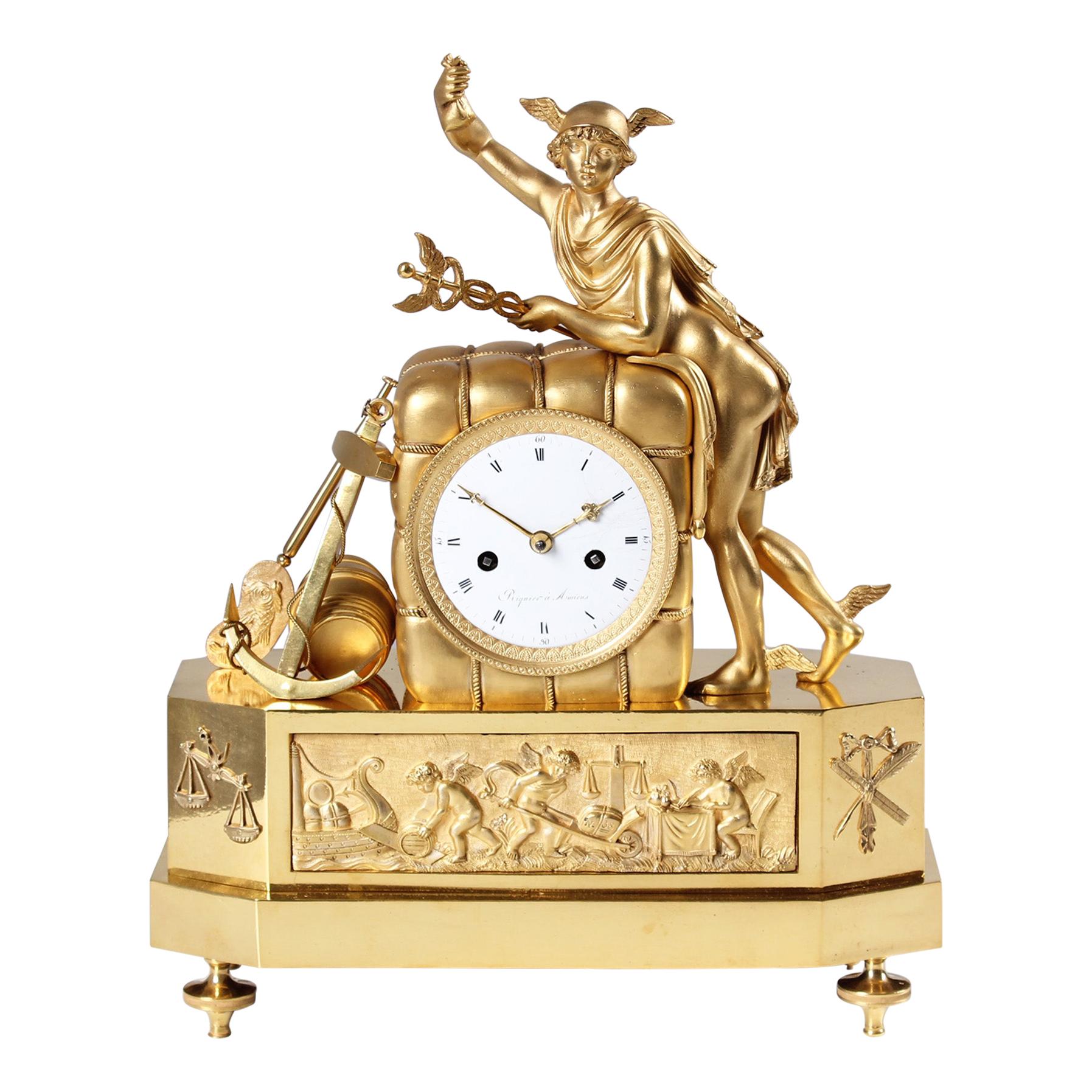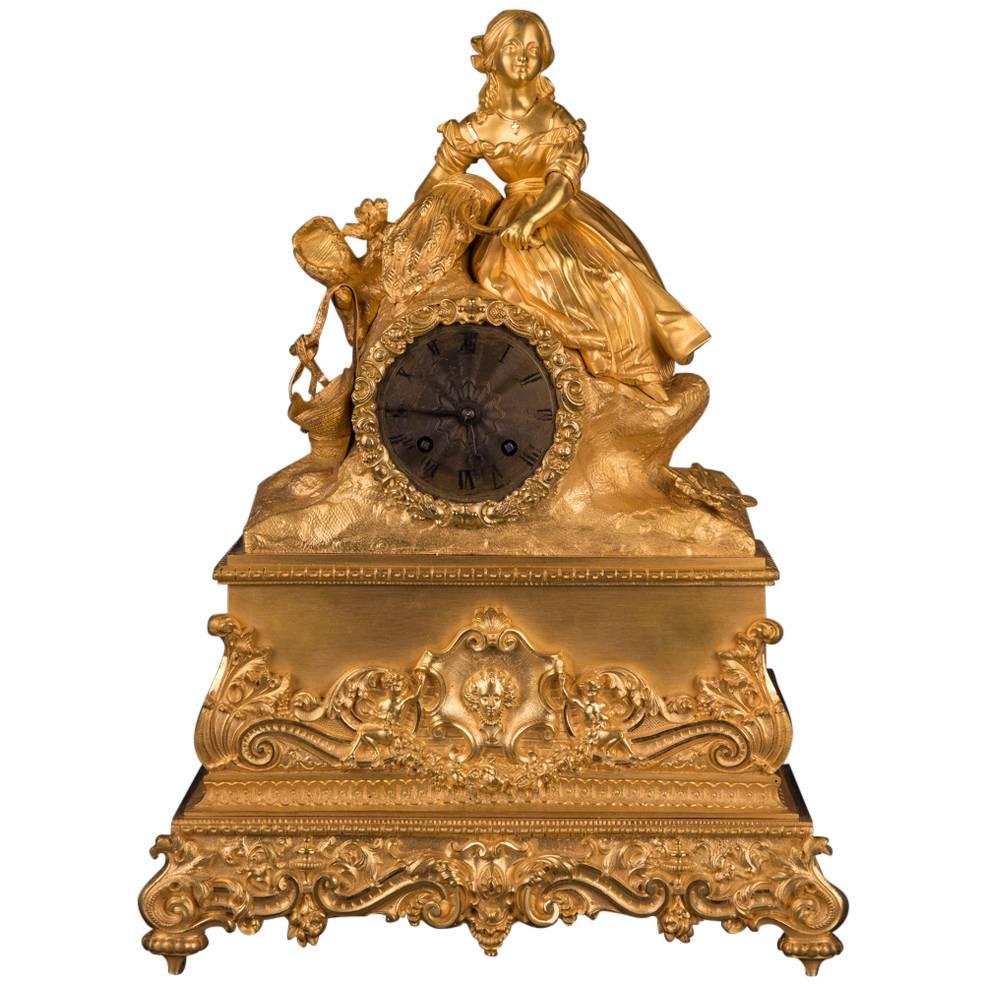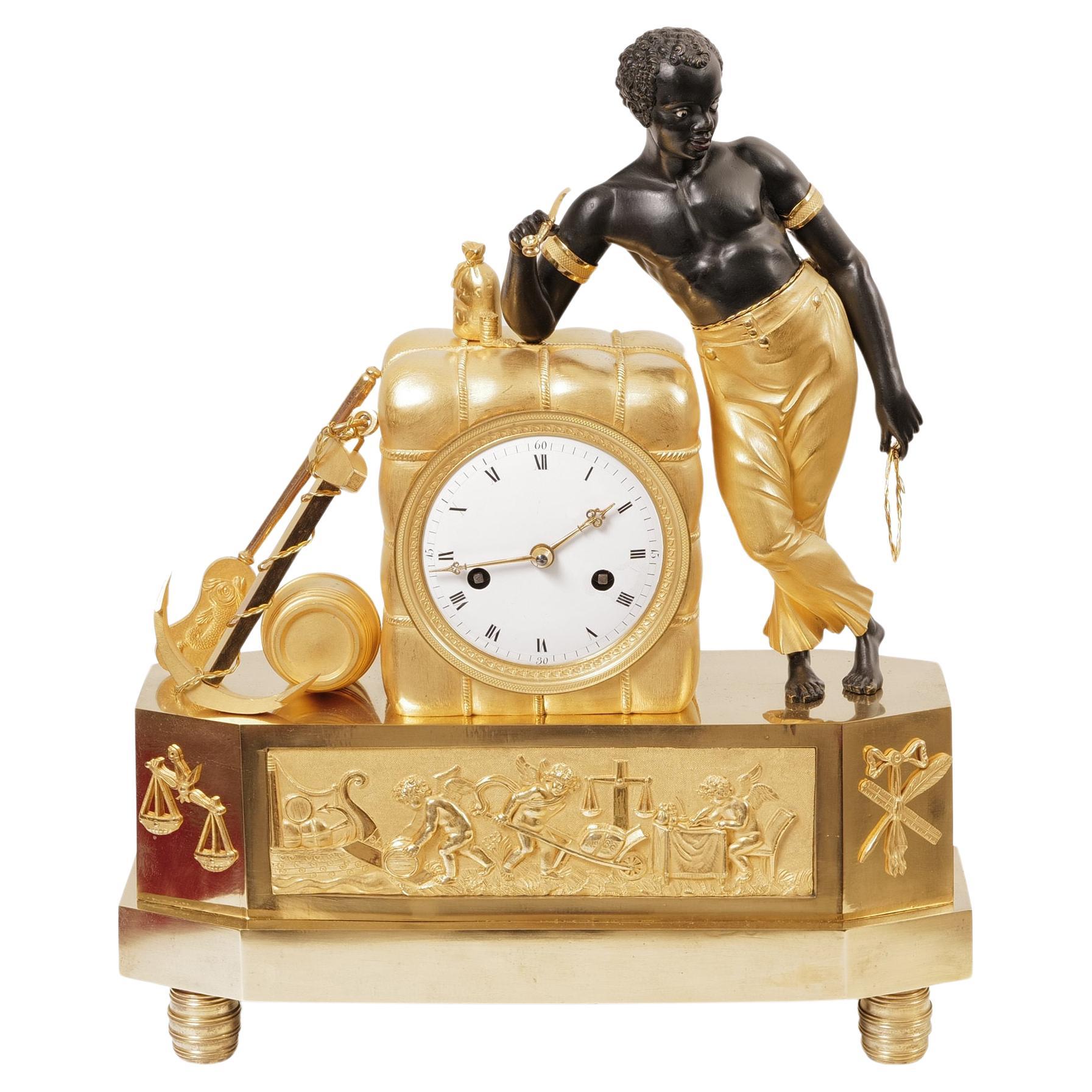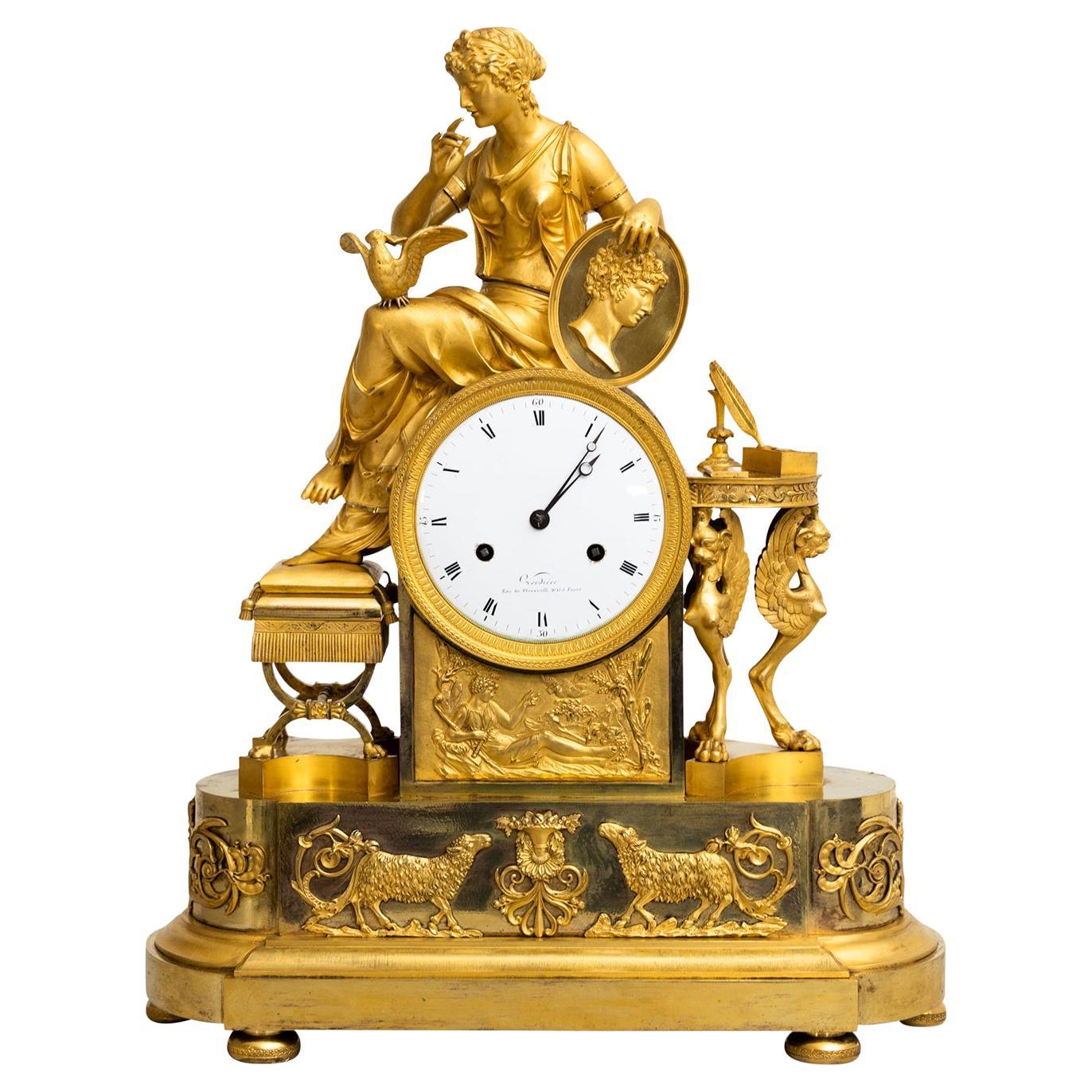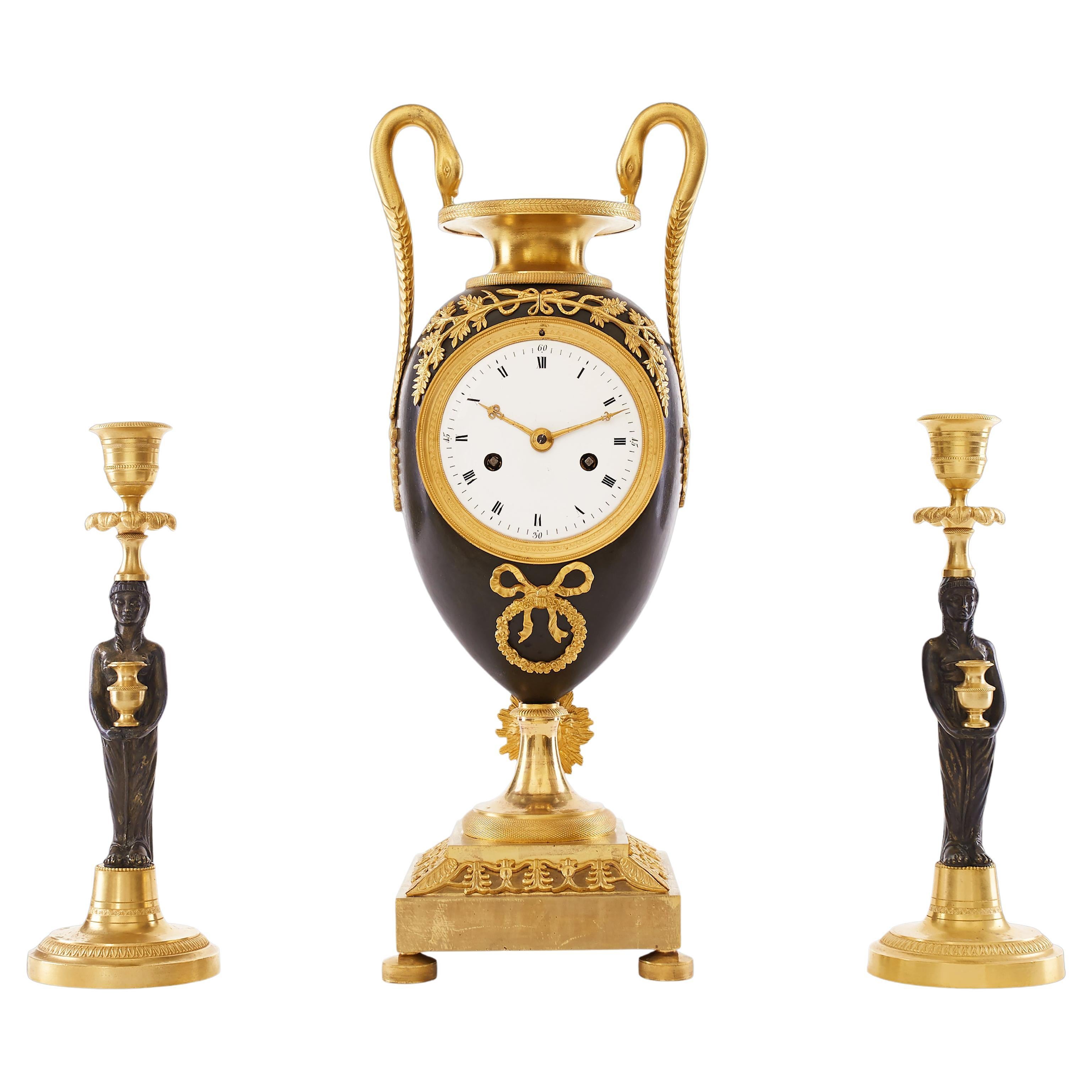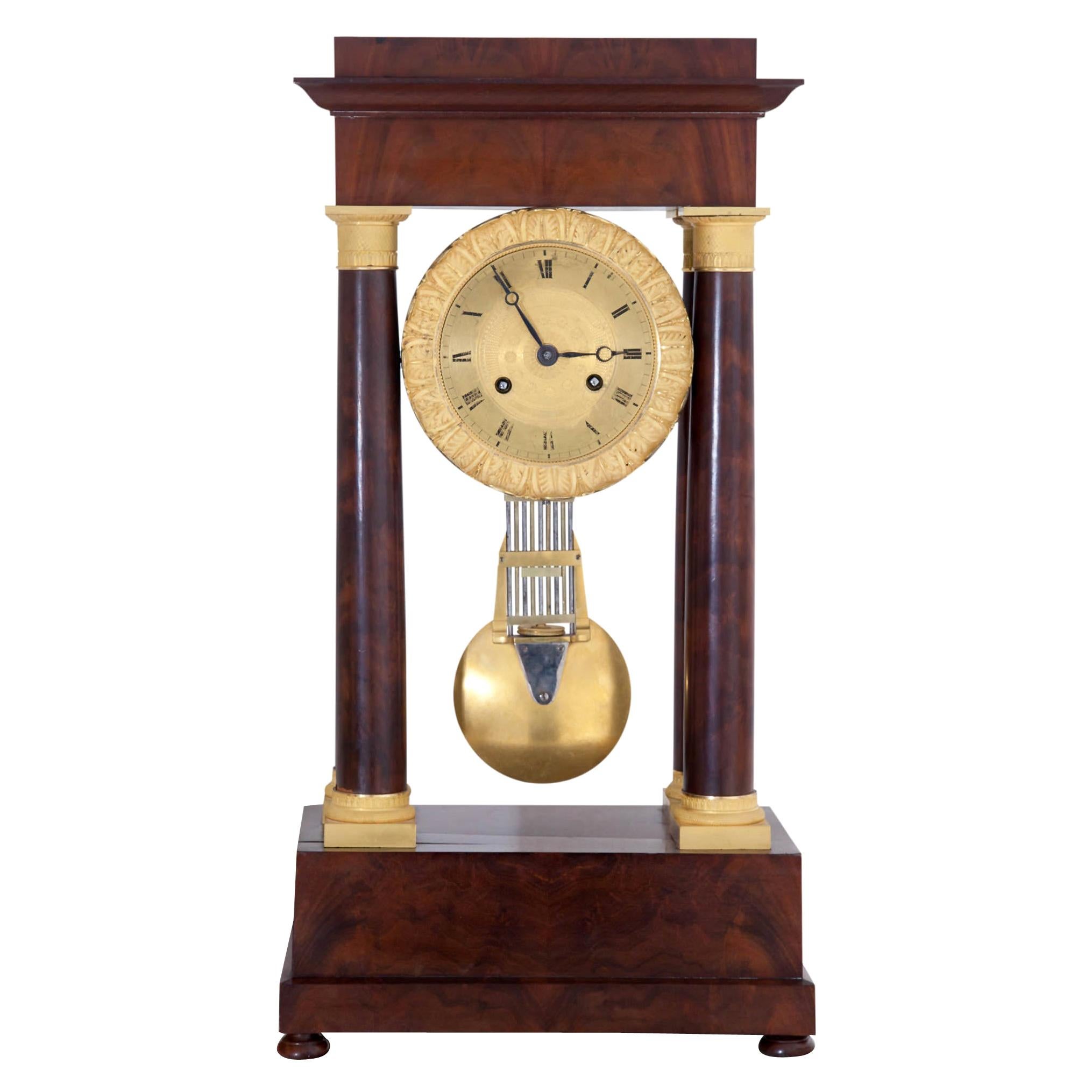Items Similar to Early 19th Century Vase Pendule, Pendulum-Clock, Tardy à Lyon, Empire circa 1820
Video Loading
Want more images or videos?
Request additional images or videos from the seller
1 of 15
Early 19th Century Vase Pendule, Pendulum-Clock, Tardy à Lyon, Empire circa 1820
About the Item
Antique vase clock
France
Fire gilded bronze
Empire around 1820
Dimensions: H x W x D: 41 x 13 x 12
Description:
Beautiful all gilt French mantel clock.
The basic form is in the shape of an urn vase with lid and side handles.
Approximately square base with applied flower basket in bas-relief.
The dial is centered in the front view of the vase and is framed by a finely chased bezel. In the four corners we see applied arrows.
The side-mounted female faces, so-called caryatids support the handles, which in turn end in heads of dolphins or mythical creatures at the top.
The heart of the clock is a classic French pendulum movement with thread suspension of the pendulum and lock wheel striking. Strike on bell on the half and full hour. The duration of the movement is one week.
Black Roman numerals, Breguet hands. In the lower part of the dial we can see the signature: Tardy à Lyon.
Condition:
Completely overhauled movement, flawless in function. Cleaned bronze with light rubbing of fire gilding on the sides.
This vase clock is illustrated in the literature:
Elke Niehüser - The French Bronze Clock p. 267.
- Dimensions:Height: 16.15 in (41 cm)Width: 5.12 in (13 cm)Depth: 4.73 in (12 cm)
- Style:Empire (Of the Period)
- Materials and Techniques:
- Place of Origin:
- Period:
- Date of Manufacture:1820
- Condition:Wear consistent with age and use. Completely overhauled movement, flawless in function. Cleaned bronze with light rubbing of fire gilding on the sides.
- Seller Location:Greven, DE
- Reference Number:1stDibs: LU5419227081202
About the Seller
5.0
Platinum Seller
These expertly vetted sellers are 1stDibs' most experienced sellers and are rated highest by our customers.
Established in 2014
1stDibs seller since 2020
114 sales on 1stDibs
Typical response time: <1 hour
- ShippingRetrieving quote...Ships From: Münster, Germany
- Return PolicyA return for this item may be initiated within 14 days of delivery.
More From This SellerView All
- 19th French Empire Mantel Clock, Pendule, Mercury, Gilded Bronze, circa 1815Located in Greven, DE19th century French pendule, mantel clock - Mercury the messenger of the gods France Bronze gilded Empire around 1815 Dimensions: H x W x D: 37 x 30 x 10 cm Description: French Empire...Category
Antique Early 19th Century French Empire Mantel Clocks
MaterialsBronze
- 19th Century Travel Clock with Repetition, Carriage Clock, Pendule de VoyageLocated in Greven, DETravel clock with repetition France Brass 19th century Dimensions: H x W x D: 11 x 7,5 x 4,5 cm Description: Small travel clock, so-call...Category
Antique 19th Century French Carriage Clocks and Travel Clocks
MaterialsBrass
- Early 19th Century Mantel Clock, Firegilt Bronze, Paris circa 1810Located in Greven, DEVery rare "Au Bon Sauvage" mantel clock France Fire-gilt and patinated bronze Empire around 1810 Dimensions: H x W x D: 34 x 41 x 13 cm Description: Extremely rare French bronze m...Category
Antique Early 19th Century French Empire Mantel Clocks
MaterialsBronze
- Early 19th Century Ormolu Mantel Clock, Atala freeing Chactas, Paris, circa 1810Located in Greven, DEMantel Clock "Atala and Chactas" Paris Bronze (fire-gilt and patinated), enamel Empire around 1810 Dimensions: H x W x D: 40 x 32 x 11 cm Description: Very rare and extremely high quality French mantel clock, so-called Pendule Au Bon Sauvage. Depicted are scenes from the love story "Atala or the love of two savages in the desert" written by Francois René Vicomte de Chateaubriand in 1801. At the beginning of the 19th century, this was probably the most famous love story in Europe, but today it has been forgotten. The story, set in present-day Louisiana (USA), is roughly rewritten about the forbidden love between Chactas, a young Indian, and Atala, the beautiful daughter of a Spaniard. Chactas is captured in a battle between two Indian tribes, chained to a palm tree and is to be sacrificed. Atala wants to save his life and convert him to Christianity. She unties him from the palm tree at night and they flee together into the wilderness of North America. Their love for each other grows stronger and stronger and they have prospects for a future together. The story takes a tragic turn when Atala, who must remain a virgin due to a vow made by her mother, can no longer withstand the conflict of her feelings and commits suicide. The main group of characters thus shows Chacta's liberation through Atala. Atala is leaning against a pile of logs. The animal fur thrown over the logs and the weapons leaning against the stack on the right give the impression of a night camp. The bronze is of rarely beautiful quality, finely chiselled and makes the scene appear very lively. The contrast of fire-gilded and patinated bronze adds tension to the composition. In the base we see the Entombment as the end of the tragic love story. This bronze work is also very detailed, the interplay of bright and matt gilding makes the flat relief appear much deeper than it is. The depiction of the mantel clock presented here shows that the exotic was only known from stories and that the bronzier had his own ideas about the appearance of this distant world. The Indian, for example, has very European facial features and his skin was not black in reality, of course. The palm tree was also certainly not found in the North American wilderness. The heart of the clock is a French pendulum movement, integrated into the wooden pile, with an eight-day power reserve and a lock plate striking a bell on the half and full hour. The pendulum is suspended on a thread, typical of the period. The classically shaped hands, so-called Breguet hands, are also typical of the time. The enamelled dial has black Roman hour numerals, Arabic quarter hours and bears the signature: Le Roy hr. de Madame A PARIS. Interesting facts: The period from 1795 to about 1815 saw the creation of probably the most spectacular group of bronzes: The "Au bon Sauvage" pendulums - depictions of the "Noble Savage". Today's viewers react to these objects with both fascination and irritation. Enthusiastic on the one hand about the obvious quality of the detailed bronzes and the allure of the exotic, on the other hand distanced and cautious because of the possible discrimination that is suspected behind them. The ambivalence of this feeling motivates the search for the conditions of origin of these pendulums. Europeans found their new ideal of the natural man primarily in fictional and realistic travelogues about the Indians of North America...Category
Antique Early 19th Century French Empire Mantel Clocks
MaterialsOrmolu
- Empire Mantel Clock - La Bibliotheque, Ormolu, France, Paris, circa 1820By Le RoiLocated in Greven, DEMantel Clock - La Bibliotheque - In the study room Paris fire-gilt bronze, enamel Empire around 1820 Dimensions: H x W x D: 38 x 28 x 19 cm Description: Scenery mounted on an oval...Category
Antique Early 19th Century French Empire Mantel Clocks
MaterialsBronze
- 19th Century Mantel Clock "Astronomy", France circa 1830Located in Greven, DEAntique mantel clock on the theme of astronomy France Bronze Charles X around 1830 Dimensions: H x W x D: 48 x 19 x 10 cm Description: Unusual and beautifully crafted bronze mante...Category
Antique 19th Century French Charles X Table Clocks and Desk Clocks
MaterialsBronze
You May Also Like
- 19th Century Empire Bronze Fire-Gilded PenduleLocated in Berlin, DEGreat bronze pendulum. Base and pedestal with lavish floral and figurative embellishments such as rocaille, acanthus leaves, cartouches, garlands, putti and central masks. Additional...Category
Antique 19th Century French Empire Table Clocks and Desk Clocks
MaterialsBronze
- Early 19th Century French Empire Pendule "au bon sauvage" MatelotLocated in Münster, DEPendule "au bon sauvage" Matelot Paris, Empire circa 1810, bronze, fire-gilded and patinated, enamel Eight-day movement with lock disc and thread suspension, strike on bell on the ...Category
Antique 1810s French Empire Mantel Clocks
MaterialsBronze
- 19th Century Gold French Empire Gilded Bronze Table Clock, Antique PenduleLocated in West Palm Beach, FLA gold, antique French table clock, pendulum made of hand crafted fire-gilded bronze, in good condition. The circular enamel dial of the Pa...Category
Antique Early 19th Century French Empire Mantel Clocks
MaterialsMetal, Bronze
- Set Vase Clock 19th Century Style EmpireLocated in Warsaw, PLThis Etruscan vase-shaped mantel clock cast from bronze with gilded elements and brown patina originated from the first half of the nineteenth century. The Empire style was based on ...Category
Antique 19th Century French Empire Table Clocks and Desk Clocks
MaterialsBronze
- Empire Portal Clock, France, Early 19th CenturyLocated in Greding, DEPortal clock on a rectangular, stepped base in mahogany veneered with small bun feet. The stepped architrave is supported by four smooth columns, the capi...Category
Antique Early 19th Century French Empire Mantel Clocks
MaterialsBronze
- Empire Mahogany Grandfather Clock, early 19th CenturyLocated in Greding, DELarge Empire grandfather clock with a mahogany-veneered case in the shape of a lyre. The grandfather clock stands on a chest with three drawers and diamond-shaped fillings. Above it ...Category
Antique Early 19th Century German Empire Grandfather Clocks and Longcase...
MaterialsEnamel
Recently Viewed
View AllMore Ways To Browse
Lyon Antique
French Pendulum Clock
Antique French Clock Pendulum
Pendulum Mantel Clock
Antique Pendulum Mantel Clocks
Antique Pendulum Mantel Clock
Enamel Bell
Antique Mantel Clocks With Pendulum
Half Empire
Classic Clocks
19th Century Empire Clock
Early 19th Century French Clock
Full Mantel
Antique Lyon
Pendulum Clock Gilt Bronze
Call Bell
Antique Corner Clock
French Gold Pendulum Clock
